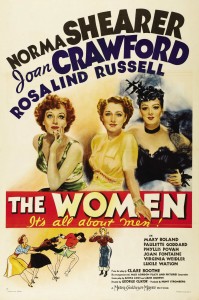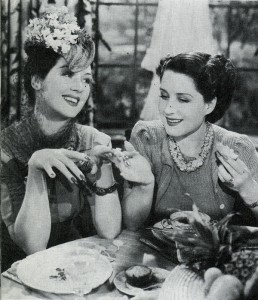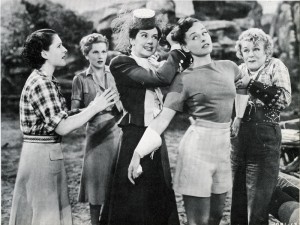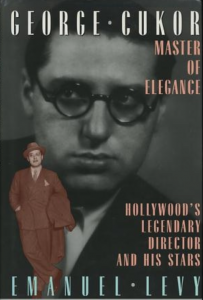 Claire Booth’s stinging play, about the wisecracking cattiness of wives and mistresses of the upper class, was a smash-hit on Broadway. For many, it “confirmed” men’s suspicions (and fantasies) of what women are talking about when there are no men around.
Claire Booth’s stinging play, about the wisecracking cattiness of wives and mistresses of the upper class, was a smash-hit on Broadway. For many, it “confirmed” men’s suspicions (and fantasies) of what women are talking about when there are no men around.
The satire is reminiscent of Dinner at Eight; there’s desperation underlying the comedy. Anita Loos wrote most of the script, but George Kauffman was brought in for rewrites; an early draft was reportedly written by Scott Fitzgerald! Faithful to the play, The Women added an opening sequence and laundered some of the more risque lines.
Unfortunately, a great number of the funniest lines were blue-penciled by Hollywood censors. “The most innocent jokes about sex were banned,” recalled Anita Loos who, along with Jane Murfin, worked on the screenplay. Loos was instructed to sit beside Cukor on the set and ad lib “clean” jokes. This did not prove difficult. Quick and witty, Loos found plenty of humor in the ordinary bitchiness of women. One lively scene, where all the women go to the ladies room at the same time to gossip about their hostess, was invented by Loos on the set.
 Director George Cukor knew that the central story was weak, that what was interesting was the circus ambiance and the episodes around it.
Director George Cukor knew that the central story was weak, that what was interesting was the circus ambiance and the episodes around it.
The first ten minutes–short, impressionistic scenes that introduce all the ladies going about their business, were his idea. Cukor’s pacing of the dialogue is fast, crisp and beautifully timed.
When the film was made, kept women and marital breakups were big moral questions. In later years, Cukor mused that, given changing times and conventions, if The Women were made now, “everybody would be screwing everybody, and everybody would know about it.” And he envisioned wilder antics among the characters–like Crystal carrying on with another girl rather than being a kept woman. But even by today’s standards, Cukor’s film is remarkably freshand funny.
The all-star cast includes: Norma Shearer, Joan Crawford, Rosalind Russell, Joan Fontaine, Paulette Goddard. No men appear in the movie, even in minor roles–a novel idea for 1939. At the end of the story, a male shadow is visible on screen. Cukor reportedly tested three actors for their ability to cast the shadow!
 Under Cukor’s direction, the nuances in all the women’s speeches were witty. Uncharacteristically, Cukor even made a few textual suggestions, like adding the famous line of Mary Brian, who played the Countess–“l’amour, l’amour.”
Under Cukor’s direction, the nuances in all the women’s speeches were witty. Uncharacteristically, Cukor even made a few textual suggestions, like adding the famous line of Mary Brian, who played the Countess–“l’amour, l’amour.”
Cukor’s dealings with producer Stromberg were not uniformly positive. Cukor had to compromise his vision, in accordance with MGM’s notions of how to please an audience. Cukor emphasized the satirical elements of the characters. With the exception of Mary, Shearer’s straight, humorless lady, none of the women seem to mind how awful she is–which is why the comedy has aged well. But MGM wished to stress the happy ending, which was meant to assure audiences that a nice woman can always keep her husband.
My Biography of George Cukor
Cukor also lost the battle with Stromberg over the fashion show scene, which had nothing to do with the film but was inserted to make the picture more exciting. Imposed by the front office, this color sequence reflected Stromberg’s silly wish to give the public something extra-special. This sequence wasn’t very good, and what’s more, it made the black and white footage that followed look bad.
 For his research, Cukor went to a real fashion show, but he realized that the nuances were difficult to duplicate on screen. Regrettably, color was such a novelty in 1939 that this sequence received considerable attention. But it was too long, about five minutes, and halted the narrative’s dramatic progress.
For his research, Cukor went to a real fashion show, but he realized that the nuances were difficult to duplicate on screen. Regrettably, color was such a novelty in 1939 that this sequence received considerable attention. But it was too long, about five minutes, and halted the narrative’s dramatic progress.
The Women was actually one of the easiest film Cukor had ever directed. He explained it rather simply: “When one deals with stars, he is dealing with intelligent people. If they weren’t intelligent, they wouldn’t arrive at the star pinnacle. Stars understand the business. They have learned that a show of temper gets them nothing, save perhaps a salary suspension or at least headache.”
At the end of shooting, Cukor sat back and smiled, for he won a new lucrative contract on the merit of The Women.











